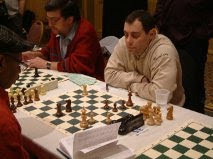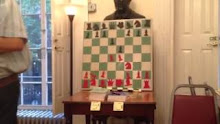1.b3 b6 2.Bb2 Bb7 3.f4 e6 4.Nf3
Better is 4.e3 Nf6 5.Nf3, Larsen-Wade, Hastings 1972, which continued 5...c5 6.Bd3 Nc6 7.O-O Qc7 8.Nc3 a6 9.a3 d5 "with a complicated and unclear position", according to Raymond Keene. [West]
4...Bxf3!?
Black tries a favorite idea of Larsen's, but with colors reversed. Compare the game position with Larsen-Bellon, Palma 1971: 1.b3 b6 2.Bb2 Bb7 3.e3 f5?! 4.Be2 Nf6 5.Bxf6! exf6 6.Bf3. White went on to win in 33 moves. [West]
5.exf3 Nf6 6.Nc3 Nc6 7.Ne4?!
I was trying to undouble the f-pawns and open the a1-h8 diagonal. [Ferrero]
7...Nd5?!
Moving the same piece twice before one's development is complete can hardly be recommended for either player. Rather than 7.Ne4?!, White should have played 7.Be2 followed by 8.O-O. Black, in turn, should have countered 7.Ne4?! with 7...Be7, 8...O-O, and 9...d5, gaining a tempo for development by kicking the knight on e4. [West]
8.g3 f5 9.Nc3?
Correct is 9.Nf2, providing additional protection for the kingside while at the same time leaving the a1-h8 diagonal open for the queen bishop. After 9.Nf2, the vulnerability of the g7 square makes it difficult for Black to complete his kingside development without retreating the king knight to f6. [West]
9...Nxf4!?
A very nice piece sacrifice by Turner to smoke out the white king into the open. [Ferrero]
10.gxf4 Qh4+ 11.Ke2 Bc5
After the nice shot on move 9, Black misses 11...Nd4+ 12.Kd3, forcing the white king even further into the open. [Ferrero]
Actually 11...Bc5 is more accurate than 11...Nd4+ 12.Kd3 since both 12...Qxf4 and 12...Bc5 can be met by 13.Bg2 with 14.Ne2 to follow. [West]
12.Qe1 Nd4+ 13.Kd3
Clearly less risky and possibly better is 13.Kd1. [Ferrero]
The game move is superior to 13.Kd1?, which would allow 13...Qxe1+ 14.Kxe1 Nxc2+ and 15...Nxa1. After 16.Bxa1, Black's rook and two pawns are better than White's extra knight and bishop because of White's shattered pawn formation. [West]
13...Qxf4 14.Qg3 Qh6?
Now Black starts to go astray. He still had time to land on top with 14...Qxg3 15.hxg3 Nxf3 16.Bg2 Ne5+!. [Ferrero]
After 14...Qxf3+ 15.Qxf3 Nxf3 16.Bg2 Ne5+ 17.Ke2 O-O-O 18.Nb5 Nc6, an unclear position would have been reached. Black would retain three pawns for the sacrificed knight, since 19.Bxg7?? runs into 19...Rhg8 and 19.Bxc6 dxc6 20.Nxa7+? leaves the knight with no retreat after 20...Kb7. Instead, after your suggestion of 14...Qxg3 15.hxg3 Nxf3 16.Bg2 Ne5+, White would gain a material advantage following 17.Ke2 O-O-O 18.Nb5 Nc6 19.Bxg7 Rhg8 20.Rxh7. [West]
15.Ne2 Bd6 16.Qg2 Nxe2 17.Kxe2?
Better would be 17.Bxe2 followed by 18.Rag1. [West]
17...e5 18.f4?
Much better is 18.Re1 followed by 19.Kd1. [West]
18...O-O 19.fxe5
First 19.Qd5+, followed by 20.fxe5, may be better but seemed very risky to me with Black's queen on h6 and rook on f8. [Ferrero]
19...f4!?
Although this looks like a mistake, overlooking White's intermediate 20th move, Black's plan is to rip open the e-file and f-file for the sacrificed material. [Ferrero]
Black's only other chance to complicate matters is 19...Rae8 20.d4 c5. [West]
20.Qd5+ Kh8 21.exd6 Rae8+ 22.Kf3?!
Not 22.Kf2 c6!, booting the queen off the fifth rank, and Black's attack is dangerous. Or 22.Kd1? Qh4!, setting up all kinds of back rank threats. [Ferrero]
The safe retreat is 22.Kd1 Qh4 23.c4. [West]
22...Qg6??
Black still had to play 22...c6!. [Ferrero]
On 22...c6! 23.Qd4 Qh5+ 24.Kf2 Qh4+ 25.Kg1 Qg4+ 26.Bg2 Re2 27.Qxg7+ Qxg7 28.Bxg7+ Kxg7, White would not have time for 29.Rd1 f3 30.Bf1 f2+ 31.Kg2 Re1 32.Bd3 f1=Q+ 33.Rxf1 Rfxf1. So at least two white pawns would fall. Considering the dangerous f-pawn and White's cramped position, the position would have been very much in doubt after 22...c6!, unless White wanted to allow perpetual check with 25.Kf3 instead of 25.Kg1. [West]
23.Bd3 Qh6 24.h4
This keeps the black queen from h4. Both 24.Rag1 and 24.dxc7 are possible. [Ferrero]
Both 24.Rag1 and 24.dxc7 are inferior, due to 24...Qh3+ with at least perpetual check for Black. For example, 24.dxc7 Qh3+ 25.Kf2 Qh4+! 26.Kg1?? f3!. Black threatens both 27...Re1+ and 27...Qg4+, and 27.Be5 fails to 27...Qg5+. [West]
24...cxd6 25.Rag1 Re7 26.Qg5 Re6??
Now Black loses by force. [Ferrero]
27.Qxh6 Rxh6 28.Bxg7+, Black resigns.
{Today Steve Ferrero is editor of Atlantic Chess News where this article originally appeared in 1992}




























